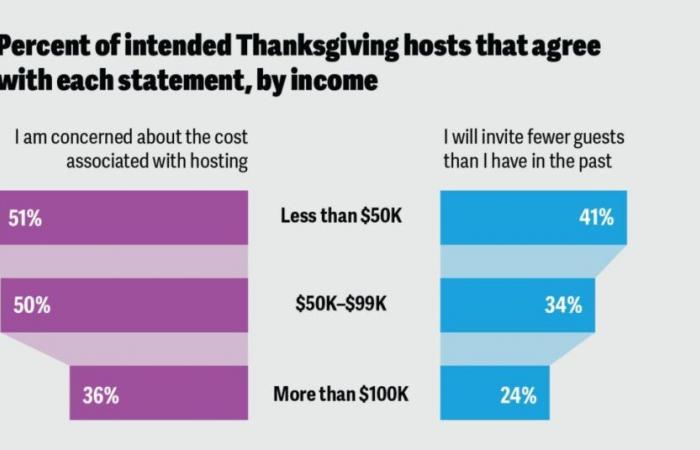Age demographics also matter, and Gen Z hosts seem especially affected this year. In our survey, they were the most likely to report concerns about costs (61%) and the most likely to reduce their guest lists (49%). Gen Zers’ disposition could be partly due to an income effect, as younger people tend to make less income,6 but it may have something to do with more limited experience hosting. Hosting as a priority is less a part of Gen Z traditions (10 percentage points lower than other generations), many of which are likely still being established in younger households.7
Some hosts may look to control costs in other ways besides inviting fewer guests. Three in 10 respondents (30%) say they will serve or eat a less fancy meal this year featuring lower-cost dishes. Those guests lucky enough to get an invite would be expected to help, according to those surveyed. Four in 10 overall say this year it is more important than before for guests to bring something to help offset the costs of hosting.8 Almost half of hosts (47%) plan to ask their guests outright to bring something.9 And indeed, 92% of guests do plan to bring something. On average, they plan to spend just over US$47 on their offering.10
More potluck-style gatherings might create a stronger sense of community for hosts and guests alike, but some will be left out entirely this Thanksgiving. Almost one in 10 surveyed (9%) already know they aren’t attending a gathering. Of those, 40% say they are not celebrating with others due to the higher food costs, 35% cite more general financial concerns, and 26% say they are scheduled to work during the holiday.11
Some retailers are leaning into holiday meal price concerns by offering specially discounted meal packages aiming to keep the cost below a certain threshold, like US$5–7 per person.12 It remains to be seen if those types of discounts will stretch into 2025 occasions or how much food and beverage company suppliers will be asked to share in the discounting.
Either way, consumers will have to continue grappling with the cost of food after Thanksgiving. The Deloitte food frugality index (FFI) tracks a basket of consumer tradeoffs and economizing behaviors over time, with higher numbers indicating consumers are tightening their purse strings.13 The latest data, which stems from a survey of 2,000 respondents, reflects the following trade-offs made by surveyed consumers:14
- 29% purchased mostly store brands
- 24% purchased mostly low-cost ingredients
- 24% purchased mostly lower-cost meats and cuts
The findings also shine a light on consumers’ other economizing behaviors:
- 35% saved by reducing at-home food waste
- 25% only bought essentials
- 19% bought less than they wanted
There is a silver lining in the data. The FFI just hit its lowest point since the index launched just over two years ago, seven percentage points below the baseline, which indicates consumers are becoming less frugal with their spending and could be a sign of growing consumer confidence. If this trend continues, by next Thanksgiving, more people could be around the table again to share the meal.






